Morocco
Things to Do
Marakesh
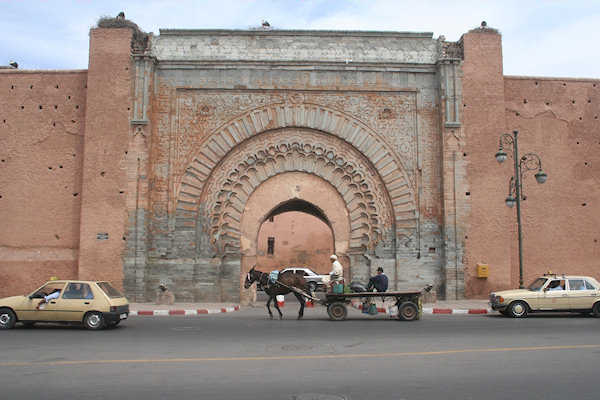 |
|||||
Capital of the south, Marrakesh is the lodestone of Cnetral Morocco, once drawing camel caravans
from the south; the oasis was the finest city many traders had ever seen. Nowadays, Marrakesh is still one
of the great tourist attractions, drawing under its mesmerising spell, countless travellers lured by its
medieval myths and mystey.
Founded in 1062 by the Almoravid sultan Youssef ben Tachfin, Marrakesh was to become one of the
Islamic world's most important artistic and cultural centres.
The city's heyday, however, was under Yousef's son, Ali. As well as palaces and baths, Ali commissioned
construction of the extensive khettara (underground irrigation canals), with still suply
Marrakesh's gardens.
Marrakesh was to remain the capital of Morocco until the collapse of the Almohad dynasty in 1269, when
the conquering Merenids moved the capital to Fès.
With the rise to power of the Saadians in the 16th century, Marrakesh again became the capital.
One of the more outstanding of the Saadian sultans, Ahmed al-Mansour - known as the golden one
because of his riches, largly accumulated in his 'conquest' of Timbuktu - left his mark with the exquisite
El-Badi palace and the Saadian tombs.
However with the accession to power of the Alawites, the capital moved to Meknés.
Under the French protectorate, the ville nouvelle (new city) was laid out and the medina (old city)
revitalised and resettled.
Djemaa el-Fna
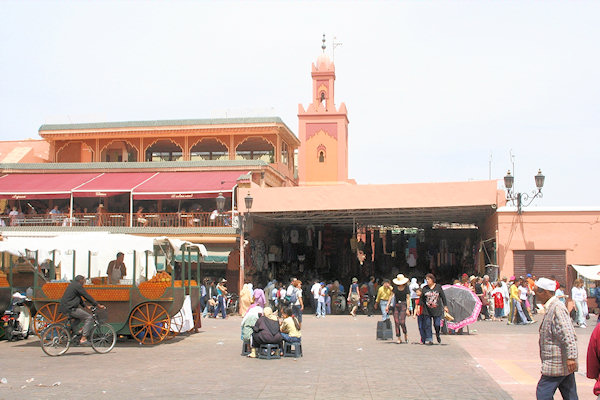 |
|||||
The focal point of Marakesh is Djemaa el-Fna, a huge square in the medina, and the backdrop for
one of the world's graetest spectacles.
There are the open-air foodstalls smoking the immediate area with mouth-watering aromas. Jugglers,
storytellers, snake charmers, musicians, the occasional acrobats and bening lunatics consume the remaining
space. Each surrounded by jostling spectators who listen and watch intently, or fall about laughing before
moving on to the next act. Naturally tourists are soon cajoled into joining in; you should expect to pay a
few dirham for the show.
On the outher edges, kerosene lanterns ablaze, are the juice stalls. Beyond them, hunched on the ground
with their eye-catching wares spread before them, herbalists sit poised to prescribe a potion for whatever
ails you.
Many believe that it is the tourists who fuel the activity in Djemaa al-Fna. This may be true in the case
of the water sellers, henna artists and snake charmers, but the vast majority of the crowed is local.
Once you've wandered the square, take a balcony seat in a rooftop café or restaurant to absorb the spectacle
at a more relaxing and voyeurtistic distance.
Souqs
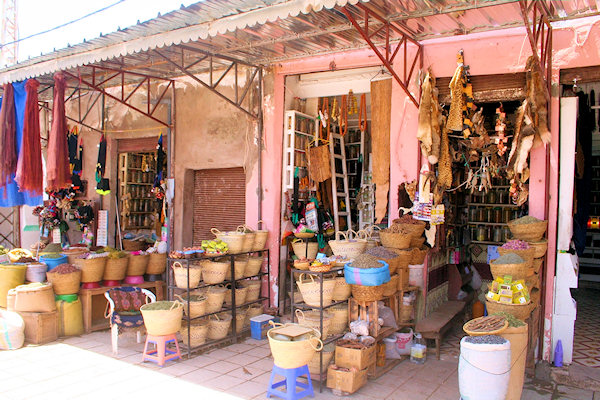 |
|||||
There is something archetypal about the souq of Marrakesh; you might belive that all other markets were
direved or refined from it, as if the word market and Marrakesh were the same thing.
As you wander through the various souqs there are plenty of upportunities to watch artisians at work
fashioning slippers, weaving rugs, dyeing textiles and hammering metals.
Koutoubia
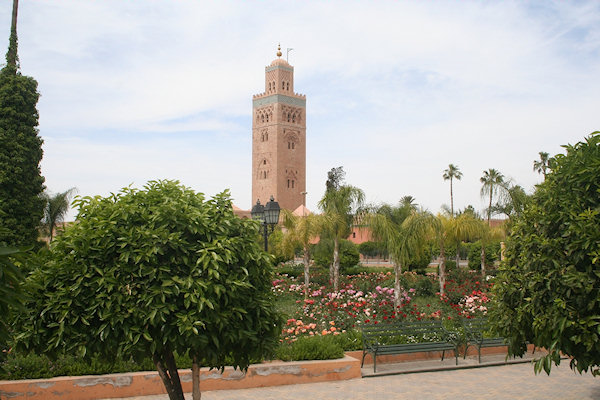 |
|||||
Dominating the Marrakshi landscape, southwest of Djemaa el-Fna, is the most famous monument the
Koutoubia. At 70 m. tall, its minaret is visible for miles in any direction. The word minaret,
originates from Arabic, Alminar or "the place of light", from where the muezzin dispels the darkness
with the word of the Holy Quran. At dusk, in the fading crimson light of evening, the resounding call to
prayer that echoes across the city has a powerful emotive effect.
Buildt by the Almohad, Yakoub el-Mansour (1184-1199), on the site of a precious 11th-century
Almoravid mosque, this is the oldest and best preserved minaret.
It is also a classic representation of Moroccan-Andalucian architecture; its features are mirrored in many
other minarets throughout the country, but not one of these matches the Koutoubia's for sheer size.
You can walk around the flowered gardens and piazza to the west where excavations have revealed traces of
the original mosque, which had to be knocked down as it did not align with Mecca.
Ali ben Youssef Medersa
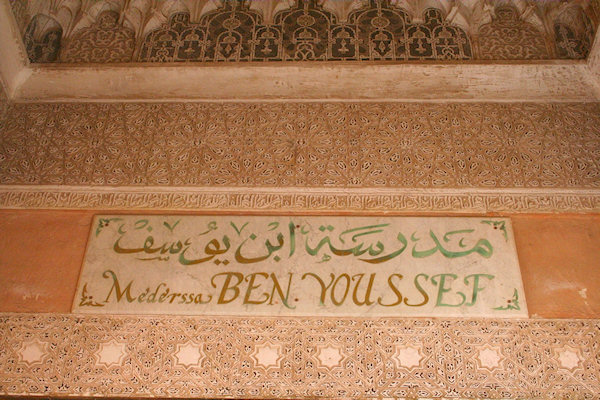 |
|||||
The medersa is the largest theological college in the Maghreb and was buildt by the
Saadians in 1565 (and much restored in the 1960's).
Altough undergoing a painstaking restoration, it is a peacful and meditative place with some absolutely
stunning examples of stucco decoration.
Upstairs the are students' cells. As usual, they are small and bare. It's hard to imagine how, as is
claimed, they crammed as many as 900 people into these rooms!
Palais El-Badi
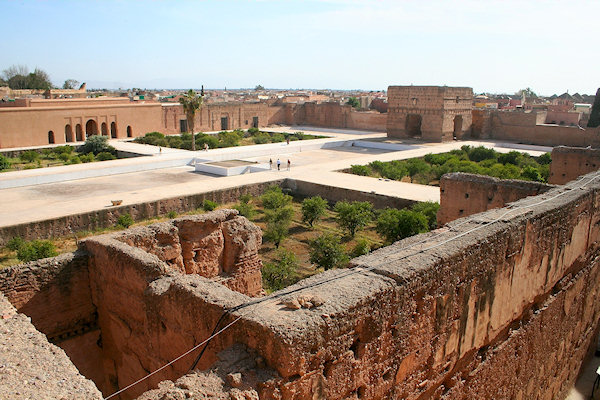 |
|||||
The most famous of the city's palaces is the Palais El-Badi. Buildt by Ahmed el-Mansour
between 1578 and 1602, at the time of its construction it was reputed to be one of the most beautiful
palaces in the world (and was known as the Incomparable).
Its scale is certainly staggering from the vast 90m long central pool surrounding by sunken orange groves,
to the towering pisé walls and the 130m-long central court.
What you can see today is still only a fraction of the whole; the private palce and apartments of
courtiens and family now incorperated in the current Royal Palace.
The largest structure to the west is the Koubba al-Khamsiniyya, which was used as a reception hall
on state occasions and was named for its 50 matble columns.
Proceeding south and you'll find yourself in a confusing maze of underground corridors, storerooms and
dungeons - a torch (flaslight) will come in handy.
Saadian Tombs
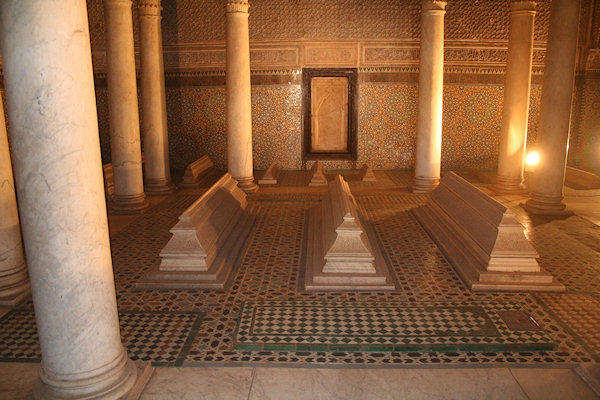 |
|||||
Long hidden from intrusive eyes, the area of the Saadian Tombs was the original previliged
cementry for decents of the prophet Mohammed.
The mausoleum is devided into three small halls. There are 66 Saadians, included AL-Mansour, his
sucessors and their closest family members, buried under the two main structures, and there are more than
100 buried outside the buildings.
The halls at either end contain tombs of children. The central Hall of the Twelve columns is held
to be one of the finest examples of Moroccan-Andalucian decorative art. Among the columns of Italian marble
are the tombs of Ahmed al-Mansour, his son and grandson. The elegant little mausoleum, set further in,
houses the tomb of AL-Mansour's mother, Lalla Messaouda.
Palais de la Bahia
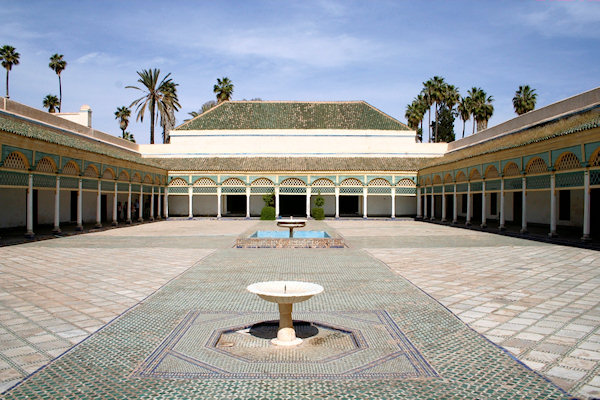 |
|||||
As the house of a Grand Vizier the Palais de la Bahia isn't bad, and it's hardly
surprising that it aroused the envy of the ruling sultan Abdel Aziz.
Buildt towards the end of the 19th century, the rambling rooms, elaborate reception halls, living
quarters, pleasure gardens, fountains and numerous secluded, shady courtyards, housed Bou-Ahmed's
family and retinue of four wives, 24 concubines and countless children.
The palis exemplifies the priority of privacy in Muslim architecture. You will often find that the
multiple doorways linking various parts of the palace are placed so that you often can't see much past
the open doorway, creating the impression of a series of seperate and unconnected zones within the wole.
The place may lack architectural cohesion, but this in no way detracts from its visual appeal.
Jardin Majorelle
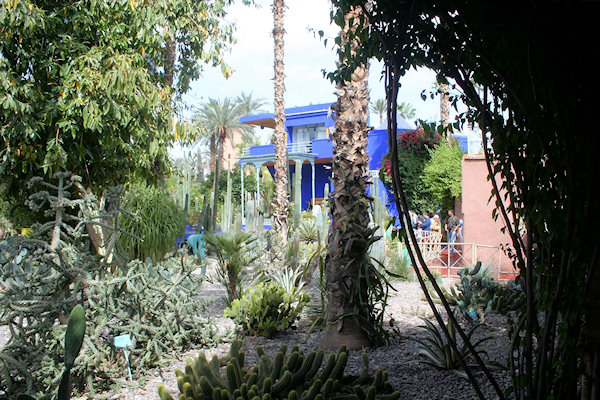 |
|||||
Now owned by the French couturier Yves Saint-Laurent, the pretty sub-topical Jardin
Majorelle provides a wonderful haven.
They where designed by the French painter Jacques Majorelle, who lived here from 1922 to 1962.
There is also a small exhibition of Majorelle's work.